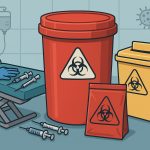Institutions in the contemporary healthcare environment are facing mounting pressure to maintain strict hygienic standards while simultaneously working toward sustainability objectives. The conflict between minimizing environmental damage and guaranteeing patient safety is becoming more and more apparent in operating rooms and outpatient clinics. An important aspect of this conversation centers on the widespread use of medical surgical disposables.
In healthcare institutions, surveillance for infections has been transformed by these recyclable devices. Wastepaper including gloves, gowns, syringes, and surgical drapes are crucial in everyday treatment since they are made to avoid contamination between tasks and protect the health of patients. But their widespread use begs the important question: how can healthcare systems keep using recyclables without making medical waste’s adverse environmental impacts worse?
Having an emphasis on items that are only used once, this essay examines how medical facilities balance the delicate balance within sustainable practices and aesthetic needs.
The Critical Role of Disposables in Infection Control
Because healthcare-associated infections (HAIs) continue to be a major issue in medical offices, avoiding infections is one of the primary goals. In this case, medical surgical disposables are their initial line of action. By decreasing the chance of contamination from improperly sanitized machinery, these solutions provide patients and professionals with peace of confidence.
Recyclable products are especially crucial for extensive operations, critical treatments, or working among patients with compromised immunity. Medical staff may work with confidence and not worry about transmitting germs because everything is sanitary.
Even during global health emergencies such as the COVID-19 pandemic, the value of disposables was brought into sharp focus. Their availability enabled healthcare providers to manage high patient volumes while maintaining strict hygiene protocols.
Environmental Cost of Single-Use Medical Products
Medical disposables have a substantial negative effect on medicine, given its obvious advantages in terms of security & hygiene. Single-use plastic items make up a significant amount of clinical waste, particularly from operating units, according to the Healthcare Plastics Recycling Council.
Due to restrictions on reusing due to biological invasion, these items frequently wind up in landfills or combustion plants. As a result, there is a spurt in toxicity along with carbon dioxide releases in addition to a rise in the volume of medical waste.
This poses a significant conundrum for institutions dedicated to climate-conscious methods: should they keep putting infection control first at the expense of the planet, or compromise on hygiene to reduce garbage?
The Search for Sustainable Solutions
Institutions have been forced to reconsider their waste management plans as a result of increased awareness of the environmental effects of medical waste. Nowadays, a lot of hospitals are taking a multifaceted approach.
Segregating non-contaminated waste from biohazardous material helps cut down on needless burning.
Buying in bulk while conducting an environmental review: Some organizations are closely examining suppliers to make sure the materials and packaging are more environmentally friendly.
Where feasible, reusable alternatives are being tested and reintroduced for a few non-essential items, frequently with improved sterilization techniques.
It is not possible to replace every disposable item, especially in critical situations.
Operational and Cost Considerations
When possible, switching from disposables to reusables won’t come without its difficulties. Strict cleaning and sterilizing procedures must be followed for usable medications, which call for more time, specific tools, and training for staff. Such components have the potential to make operations more complicated and expensive, which deters smaller healthcare facilities from implementing more environmentally friendly options.
Furthermore, the initial cost for reusing systems might be substantial, yet the return from investments might not be realized for ages. Because of this, numerous leaders seem hesitant to switch unless they have faith in the long-term cost advantages and safety of reusables.
Innovation in Disposable Product Design
Companies are looking into new product resources and logistic improvements in response to environmental issues. One encouraging discovery is the creation of washable substitutes or sustainable recyclables. Organic materials that degrade more readily while sacrificing durability or cleanliness are being tested by several businesses.
Earlier adoption of such advances by schools could position them as the standard for the public and commercial health care industries by spearheading the transition to a more sustainable supply chain.
Finding the Balance
It takes skill to strike the delicate balance between safeguarding the environment and infection control. To make sure that environmental integrity and safety are maintained, facilities must continuously evaluate garbage leaders, chain of custody, and processes.
A combination of methods will probably be used in the coming years of healthcare waste handling, utilizing the dependability of medical surgical disposables in high-risk scenarios while increasing the usage of environmentally responsible alternatives in other contexts. To improve this equilibrium, additional studies, creativity, and partnership between sectors may prove necessary.
Conclusion: Toward a Cleaner and Safer Healthcare System
As medical establishments strive to meet the dual goals of patient safety and social responsibility, the debate over single-use goods becomes increasingly complicated. Though that isn’t a single, easily implemented solution, an increasing commitment to effectiveness and innovation is paving the way toward more clever, environmentally conscious methods of health care.
By adopting new technology, reconsidering buying, and making educational investments, the healthcare industry may make the shift to waste control processes that protect the environment and public health. In the process, it may reinterpret what it entails to provide honestly accountable care.
Lynn Martelli is an editor at Readability. She received her MFA in Creative Writing from Antioch University and has worked as an editor for over 10 years. Lynn has edited a wide variety of books, including fiction, non-fiction, memoirs, and more. In her free time, Lynn enjoys reading, writing, and spending time with her family and friends.















